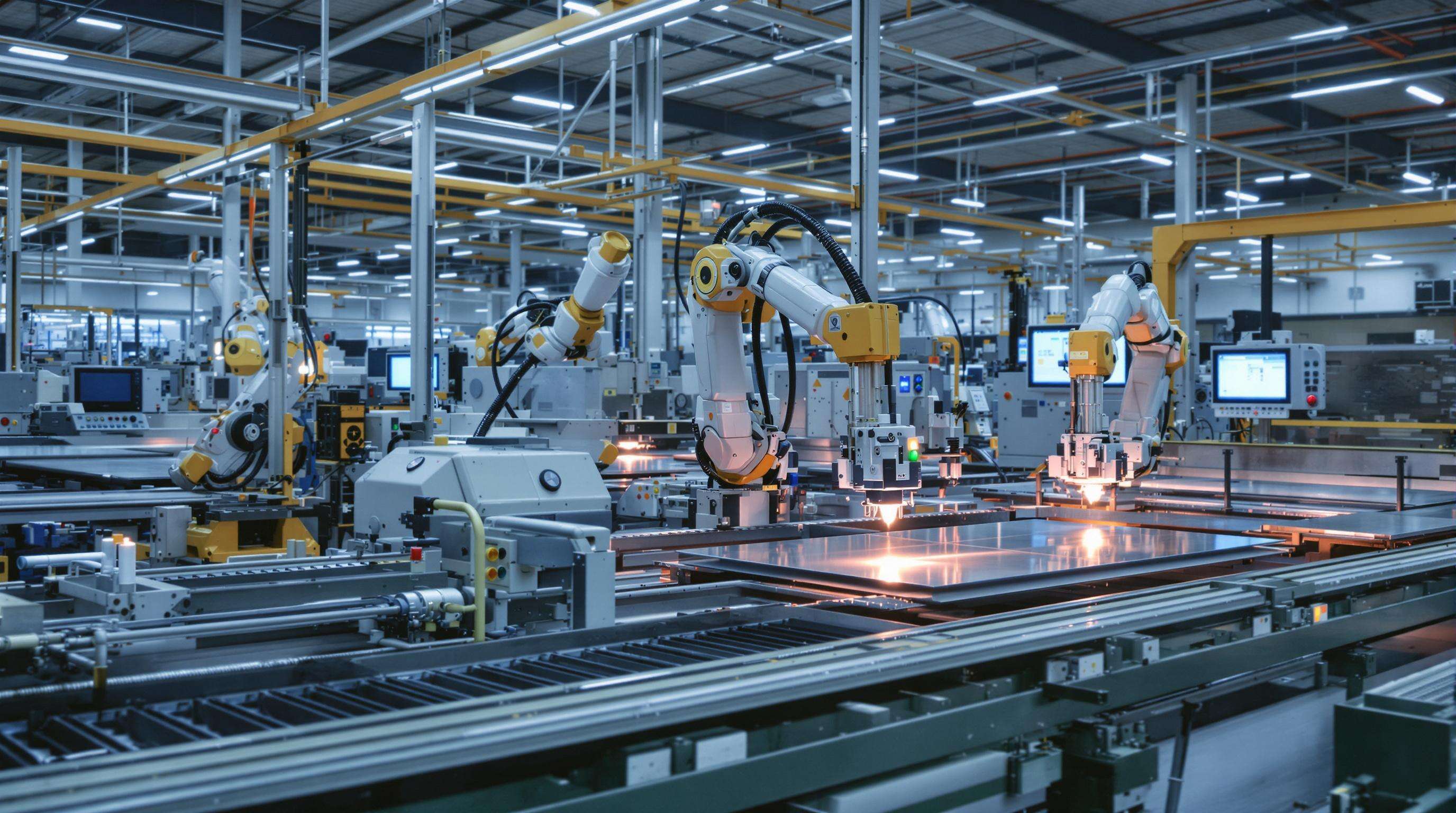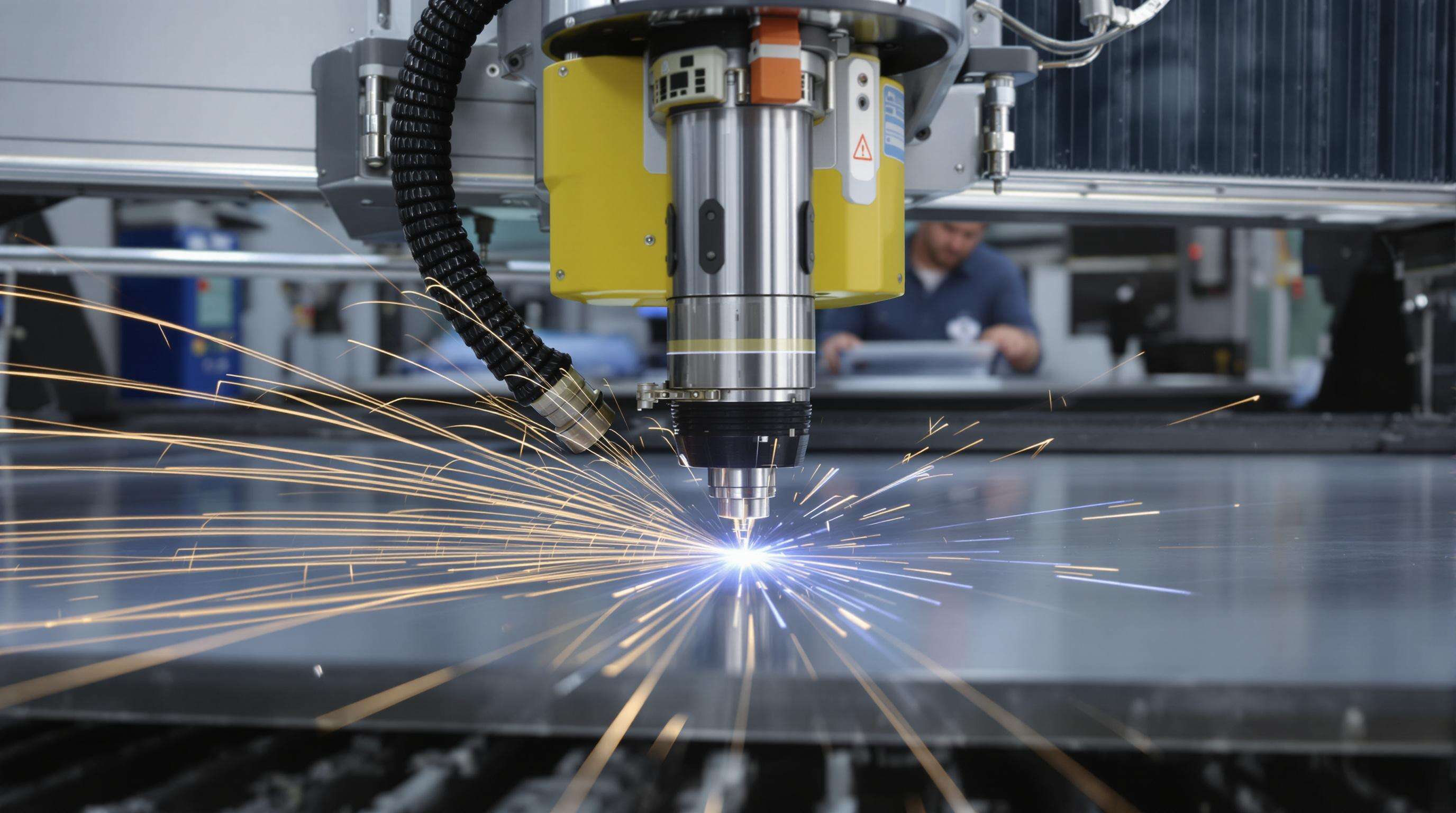Hur lasermaskiner ökar produktiviteten
Ökad produktivitet i tillverkningen med laserteknik
Lasermaskiner idag kan nå en noggrannhet på cirka 0,1 mm när de arbetar med olika material som metaller och komposit, vilket innebär att det inte finns några mer krökningsproblem som plågar vanliga mekaniska skärtekniker. Lasrar fungerar med cirka 400 tum per minut, mycket snabbare än plasma eller vattenstrålsystem, plus det är absolut inget verktygsskador involverade så de kan köra nonstop dag och natt. Ta bilindustrin till exempel, där butiker skär genom 4 mm tjockt rostfritt stål med hastigheter på 40 meter per minut idag, ungefär tre gånger snabbare än vad som var möjligt tidigare. Ett annat stort plus är att dessa maskiner skär upp installationstiden med nästan 70 procent tack vare sina programmerbara mallar. Detta gör att byten från en deldesign till en annan sker nästan omedelbart utan allt besväret med att omarbeta allt från grunden.
Snabbare och mer exakta laserskärmaskiner ökar produktionen
Fiberlaser med effekt mellan 6 kW och 20 kW kan skära genom 1 tum tjockt kolstål ungefär fyra gånger snabbare än traditionella CO2-system, samtidigt som de använder cirka 30 procent mindre energi totalt. Dessa maskiner är utrustade med smarta optiska system som ständigt justerar saker som brännpunkter och gastrycksinställningar, vilket hjälper till att hålla skärkvaliteten stabil även när de körs i toppfart. Enligt en undersökning som publicerades förra året såg tillverkningsfabriker som använde dessa hybridlasersvetsningssystem minskar produktionscyklerna med nästan hälften jämfört med vad de fick från separata utrustningsinställningar. Siffrorna talar för sig själva.
Datainspektion: 40% ökad genomsnittlig produktion med lasermaskinintegration
Tillverkare som använder laserautomation rapporterar en produktivitetsökning på 36-44% inom 8 månader (Metallbearbetningsbranschens rapport 2024). Bland de viktigaste drivkrafterna finns:
- 28% snabbare arbetsomsättning med automatiserad häckningsprogramvara
- 19% materialbesparingar från precisionskorsbredd (0,15 mm vs 1,2 mm plasma)
- 92% öppenhet genom prediktiva underhålls sensorer
| Metriska | Laserbearbetning | Plasmaskärning |
|---|---|---|
| Energieffektivitet | 85% | 45% |
| Daglig utgång | 1200 enheter | 700 enheter |
| Skrapprcent | 2.1% | 8.7% |
Kontroversanalys: Är traditionella skärmetoder fortfarande lönsamma?
Medan 68% av tillverkarna nu använder laser för bulkorder, kvarstår traditionella metoder i nischsscenarier:
- Lågvolymarbete som kräver < 500 USD i verktygsinvesteringar
- Andra, av järn eller stål som sten/glas (vandstråle föredras)
- Fältoperationer med en effekt av högst 50 W
Men bärbara 2 kW fiberlasrar utmanar nu även dessa undantag, skär 30 mm aluminium på plats med generatorn. Debatten fokuserar alltmer inte på kompetens utan på kostnaderna för omskolning av arbetskraften - i genomsnitt 14 600 dollar per tekniker för lasercertifiering.
Automatisering och industri 4.0: Smartere integration av lasermaskiner

Automatisering av laserskärmaskiner gör det lättare att använda dem utan övervakning
Moderna lasersystem kan skapa kontinuerlig produktion genom robotbehandling av material och automatiserad jobbsättning. Integrerade synsystem justerar skärvägar inom 0,5 sekunder vid upptäckt av materialstjocklekvariationer, med en noggrannhet på ± 0,1 mm under dygnet runt. Denna automatisering gör det möjligt för tillverkare att öka skiftproduktionen med 40% jämfört med manuellt laddade system.
Industri 4.0 och IoT-integrering i lasersystem möjliggör förutsägbart underhåll
Lasermaskiner utrustade med IoT-teknik följer över 18 olika driftsfaktorer inklusive saker som strålapparat och renhetsnivån för assistantgaser. Dessa system är beroende av maskininlärningsalgoritmer som analyserar den insamlade informationen för att förutsäga när delar kan misslyckas. Enligt rapporter kan sådana förutsägande funktioner upptäcka potentiella problem upp till tre dagar i förväg med en noggrannhet på cirka 94%, vilket minskar de kostsamma nödreparationerna med ungefär en tredjedel, enligt rapporten om Industry 4.0 Adoption Report 2024. Framåtblickande förväntar sig det amerikanska handelsdepartementet att smarta tillverkningspraxis kommer att växa med cirka 12% varje år fram till 2030, eftersom fabriker i allt högre grad vänder sig till dessa sammankopplade lösningar för bättre effektivitet och tillförlitlighet.
Fallstudie: Smart fabrik i Tyskland uppnår 30% minskad driftstopptid
Ett metallverk i Bayern har implementerat IoT-sensorer på 22 laserskärmaskiner.
- 30% minskning av opranumererad driftstopptid
- 17% förbättring av energieffektiviteten genom adaptiv effektmodulation
- 25% snabbare arbetsbyte genom automatiserad verktygsstillsatsoptimering
Den digitala omvandlingen på 1,8 miljoner dollar gav full återvinning på 13 månader genom ökad genomgång och minskade skrotfrekvenser som överskrider de ursprungliga prognoserna med 9%.
Lasermaskiner med fiber: framtiden för industriell skärning

Fiberlasers ökning i industriella tillämpningar över CO2-system
Sedan 2023 har fiberlasrar tagit över de flesta nya industriella installationer, och ersätter faktiskt CO2-system i cirka tre av fyra fall. Huvudskälen? De fungerar bara bättre när det gäller att spara energi och minska driftskostnaderna. Traditionella CO2-lasrar behöver alla möjliga gasblandningar och dessa komplicerade speglar, medan fibertekniken förlitar sig på diodmoduler och böjbara optiska fibrer istället. Enligt några nyligen genomförda studier från International Laser Institute kan denna strömbrytare minska energianvändningen med mellan 40 och nästan hälften. Vad som gör det så bra för tillverkare är hur dessa fibersystem kan köra nonstop dag efter dag på platser som bilfabriker och flygplansdelar produktionslinjer. Och gissa vad? Underhåll blir också mycket mindre frekvent ca 35% mindre ofta än äldre utrustning kräver. Det betyder mindre stillestånd och lyckligare fabrikschefer överallt.
Fiber och CO2-laserskärningsteknik: Effektivitetsjämförelse
| Metriska | Fiberlasrar | CO2-lasrar |
|---|---|---|
| Energieffektivitet | 35-45% | 12-18% |
| Skärningshastighet (1 mm stål) | 60 m/min | 25 m/min |
| Underhållsfrekvens | Var 15:e timme | Var tredje timme |
| Mångsidighet av material | Metaller, kompositmaterial | Plast, tyger |
Fiberlaser uppnår 0,01 mm upprepas i metallbearbetningkritiskt för EV-batterier och satellitkomponentermedan de minskar värmepåverkade zoner med 60% jämfört med CO2-alternativ.
Trendprognos: Fiberlasers kommer att dominera 70% av marknaden år 2025
Enligt senaste marknadsanalysrapporter förväntas den globala fiberlasersektorn nå cirka 7,8 miljarder dollar år 2025. Tillväxten beror till stor del på att tillverkare behöver bättre verktyg för 3D-utskrift och att regeringar fortsätter att driva på för grönare fabriker. Om vi tittar på specifika regioner, hoppar metallverkstader över Asien och Stillahavsområdet ombord med dessa högeffektiva fiberlasrar med ungefär tre gånger den hastighet som ses i Europa. - Varför? - Jag vet inte. Många företag där får en avkastning på sin investering inom bara 14 månader. Samtidigt har traditionella CO2-lasrar nästan pressats åt sidan förutom de speciella fallen där de fortfarande fungerar bäst med icke-metaller. När industrin går mot smartare tillverkningsinstallationer som är kompatibla med Industry 4.0-standarder verkar fiberlasrar vinna som den lösning som används i de flesta butiker idag.
Precision och kostnadseffektivitet vid rörskärning med lasermaskiner
Precision och effektivitet vid lasermaskinskärning av metallrör
Dagens laserskärsystem kan nå en noggrannhet på mellan 0,05 och 0,1 mm när de arbetar med rör, vilket innebär att tillverkare kan skapa alla möjliga komplicerade former, inklusive de skarpa hörnen och invecklade spår utan att behöva ytterligare slutbehandling efteråt. Denna precisionsnivå hjälper verkligen till att minska materialets förvrängning och håller strukturerna starka och stabila, något som är viktigt i branscher där fel inte är ett alternativ som bilar och flygplan. Programvaran bakom dessa maskiner blir smartare också, med nätningsalgoritmer som maximerar hur mycket användbart material som kommer ut från varje ark. Vissa butiker rapporterar att de har en effektivitet på närmare 95% när de arbetar med rostfritt stål eller aluminiumrör, vilket ger verkliga besparingar över tid.
Investeringsvinster för rörlaserskärare för tillverkare av medelstora volymer
Tillverkare av medelstora produkter ser avkastning inom 12-18 månader genom att utnyttja lasermaskiner med en hastighet (upp till 120 meter/min) och automatisering. Förkortad installationstid för konstruktionsändringar och oövervakas drift sänker arbetskostnaderna med 30-40% jämfört med plasmaskärning. En medelstor HVAC-tillverkare ökade sin månatliga produktion med 22% efter att ha infört ett fiberlasersystem på 6 kW.
Kostnadseffektiva laserskärslösningar minskar skrot med upp till 25%
Laserskärning med smal kant (0,2 - 0,3 mm) och precision minskar skrotfrekvensen från 15% med traditionella metoder till 6 - 8%. Integrerade IoT-sensorer förbättrar effektiviteten genom att spåra energiförbrukningen, med avancerade system som använder 3,5 kW/timme. Fabrikerna rapporterar om 18-25% årlig besparing av materialrester och omarbetningskostnader efter att ha bytt till lasersystem.
Användning av lasermaskiner inom viktiga branscher och framtida trender
Användning inom fordons-, elektronik- och rymdindustrin
Lasermaskiner förändrar hur saker görs i många viktiga industrier eftersom de erbjuder otrolig noggrannhet och kan skala upp produktionen enkelt. Ta till exempel bilindustrin - bilar som byggs idag använder ofta lasersvetsning och skärningstekniker som fungerar cirka 27% snabbare än äldre metoder enligt en marknadsundersökning från Coherent redan 2025. Under tiden använder folk som tillverkar elektroniska apparater dessa små pulslasrar för att borra hål i kretskort med otrolig precision ner till mikronnivån. Och glöm inte flygningen heller! Flygbolag älskar fiberlasrar eftersom de kan skära igenom hårda material som Inconel utan mycket felmarginal alls. Detta innebär att flygplansdelar kan vara lättare, vilket med tiden leder till verkliga bränslekostnaders besparingar, ibland med cirka 15% beroende på konstruktionen.
Fallstudie: Ett flyg- och rymdföretag använder lasermaskin för komplexa geometrier
En tillverkare av flygplansdelar i Nordamerika minskade tillverkningstiden för turbinskvalv med omkring 40% när de införde ett nytt 6 kW fiberlasersystem för sin verksamhet. Vad som verkligen gjorde den här tekniken framträdande var hur dess adaptiva optiska funktioner gjorde det möjligt för dem att skära de tuffa titanbränsleinsprutningskanalerna med bara ett pass, vilket resulterade i nästan perfekta resultat varje gång med ca 97% konsistens. Detta eliminerade i princip alla de extra färdigställningsprocesser som brukade ta så mycket tid. När man ser vad som hände efter att ha installerat utrustningen, så var det också några ganska imponerande besparingar. Verktygskostnaderna minskade med cirka 22%, medan de lyckades få bättre värde av material i allmänhet med en ökning med 18% i hur effektivt de utnyttjade råvarorna under produktionskörningar.
Ökad användning av automatisering och AI i laserskärning ökar anpassningsförmågan
Den senaste generationen lasermaskiner börjar införliva maskininlärningsteknik som faktiskt kan förutsäga när de behöver justera sitt fokus när de skär material som tenderar att förvränga sig vid höga hastigheter. Anläggningar som har antagit denna smarta teknik tillsammans med internetanslutna underhållssystem ser en minskning med cirka 30% i oväntade nedstängningar enligt senaste branschrapporter från 2024. När det gäller de nya hybridinstallationerna där lasrar arbetar tillsammans med robotar, säger fabrikschefer att installationstiderna mellan olika produktserie har blivit ungefär 25% snabbare än vad som var möjligt med traditionella datorstyrda bearbetningscentra. Vissa butiker talar till och med om att kunna byta produktionslinje mitt i skiftet utan att förlora mycket tid.
FAQ-sektion
Vilka fördelar har lasermaskiner jämfört med traditionella skärmetoder?
Lasermaskiner erbjuder högre precision, snabbare skärhastighet, minskad verktygsskador, lägre energianvändning och större automatiseringspotential jämfört med traditionella metoder som plasma eller vattenstråle.
Hur är fiberlasrar jämfört med CO2-lasrar?
Fiberlaser är mer energieffektiva, har snabbare skärhastigheter, kräver mindre underhåll och erbjuder större mångsidighet av material jämfört med CO2-lasrar.
Vilka branscher drar mest nytta av laserskärteknik?
Bil-, elektronik- och rymdindustrin drar stor nytta av lasertekniken på grund av dess precision, skalbarhet och effektivitet vid bearbetning av komplexa geometrier.
Är lasermaskiner lämpliga för produktion i låg volym?
Lasermaskiner är kanske inte det bästa valet för lågt omfattande arbeten på grund av de inledande investeringskostnaderna, men framstegen inom bärbara fiberlasrar ökar deras lämplighet för produktionsbehov på plats och varierande.
Hur påverkar Industri 4.0 integrationen av lasermaskiner?
Industri 4.0 förbättrar integrationen av lasermaskiner genom IoT, förutsägbart underhåll och automatisering, vilket leder till ökad produktivitet, minskad driftstopp och smartare tillverkningsprocesser.
Innehållsförteckning
- Hur lasermaskiner ökar produktiviteten
- Automatisering och industri 4.0: Smartere integration av lasermaskiner
- Lasermaskiner med fiber: framtiden för industriell skärning
- Precision och kostnadseffektivitet vid rörskärning med lasermaskiner
- Användning av lasermaskiner inom viktiga branscher och framtida trender
- FAQ-sektion

